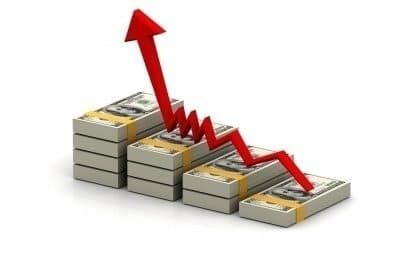Choose low costs over low returns to double profit with cost management. For example, investors picking low cost ETFs can double mutual fund returns!
Making Money With Investing Success, Lesson 4, introduces the importance of cost control using the example of ETFs delivering better returns than mutual funds. Links at the end guide you to related content if you want to learn more.
What’s in this lesson for me?
This lesson points out a basic investing truth! Investor can choose low costs or low returns! Keeping costs low improves returns for superior investors who manage costs well. Switching mutual funds into ETFs can significantly improve your investing performance.
Low costs or low returns – it’s your choice!
High returns need low costs. Many small investors who began with mutual funds are startled to learn the huge impact of high mutual fund management costs buried in the MER or management expense ratio. Any financial advisor that puts your capital into a mutual fund makes your capital works for them! At your expense!
Virtually every mutual fund has a comparable ETF that carry far lower costs. Make the switch and put the difference in your pocket or better yet, working for you in the market.
With ETFs offering huge cost savings over comparable mutual fund expenses, mutual fund investors have a choice and way to dramatically improve their returns. Switch to ETFs. Switching to ETFs offers many mutual fund holders a way to more than double their return! It is well worth your time to check it out.
Shocking management expense ratios!
Expenses for both ETFs and mutual funds expressed as the Management Expense Ratio (MER). MER fees pay management to run the fund. Comparing MERs between the most ETF and mutual funds gives investors a shock! The dramatic differences are getting picked from your pocket.
Some ETF MER costs are below 20 basis points! That is a spectacularly low fee! A basis point is 1/100 of 1%. That is 0.01%. Or compared to a dollar, a basis point is one penny! So under 20 basis points is very low – even cheap!
That happens because technology in our digital age delivers value! Compared to the all too common 2½% MER of too many mutual funds that difference is an outrageous 1,470.59%! Over 14 times as much! That means for every $1.00 in MER fees paid to manage an ETF, the comparable amount for a mutual fund is $14.71! For the same service!
Do not put up with that ripoff! Make changes to enjoy low costs double returns or better! The choice for an investor is clear. You can see how low costs double returns or better, but wait! There’s even more!
As bad as that sounds it actually can get worse yet! Mutual funds have more costs beyond the MER! Costs also include slippage during buying and selling, direct transaction cost like commissions are fully passed on to the investor. Those costs that do not directly hit EFT buyers.
Put simply, slippage is the difference between the bid and ask price. The details and full discussion would fill a book. Getting into that discussion is considerably beyond our purpose so suffice it to say ETFs are a cost-effective alternative mutual fund investors should seriously consider.
Low costs can double investment returns
To bring low cost double returns or better, help any friend, parent or grandparent. If they hold mutual funds you could be doing them a huge favor. Tell any them about basic ETFs. I also think that they should fire any financial advisor that put them into high cost mutual funds.
The advisor got paid very well for putting them in and keeps getting paid very well every year for keeping them there. Those costs all come returns that could go into their pockets. Those costs are all unrecoverable and a continuing unconscionable rip off, in my view!
If you or anyone you care about holds mutual funds, do not hesitate; dramatically and instantly improve the potential for considerably better returns. Plan, take the action needed to move and enjoy the advantages of low costs double returns or better!
Be outraged but be careful
When seeking to enjoy low costs double returns, be sure to proceed with caution. A mutual fund holder needs to get quality and objective advice. Don’t just run for the door. Pay close attention to all costs associated with exiting. Trailer fees or deferred sales charges (DSC) and other obscure costs can take a big bite. Take care and put together an exit strategy that works to your advantage.
As ever more investors learn about and jump on the lower cost ETF ride, the opportunities and advantages over mutual funds will become common knowledge. Spread the word! The move is on!
Mutual funds are seeing redemptions as funds flow into ETFs. Over $1 billion in mutual funds redemptions occurred in the year past while $10 billion flowed into ETFs. This is a very good thing.
Generally speaking, most basic ETFs are financial vehicles like or similar to a publicly listed mutual fund but with very low costs.
Next we will touch lightly on the range of other ETFs so you are aware of another large group of offerings. If they are ever suggested to you as an investment, you need an awareness of them. In contrast to the basic ETFs the exotic and advanced ETFs are not for beginners.
Mutual fund investor look at ETFs
Mutual fund investor look at ETFs. Any financial advisor that puts your capital into a mutual fund also makes your capital works for them! At your expense! Any mutual fund investor should look at ETFs for big savings.
Exchange traded funds beat mutual funds
Exchange traded funds are a better choice than mutual funds. If your financial advisor puts you into mutual funds, your account needs review . Your capital delivers a no risk and constant return…to them! What about you? You, however, get the leftovers.
Market movement up or down does not matter to their return. They get their return, every year. From you. No matter what the market does, each year they take a nice slice of your account.
You put up the capital, take the risk, but get only the leftovers. Should it be the other way around? Should they be working for you?
Moving mutual funds and ETFs
Anyone that uses mutual funds for their retirement savings needs to check their approach. If you are dealing with a company that offers only one type of investment, such as mutual funds, you need to go to another company. It could certainly be a change that pays you very well.

You can possibly do far better for yourself, at far lower costs. And yes you can get at least comparable or perhaps better performance. The big difference, very significant cost savings, compound in your favor.
Go to a company that offers alternatives including Exchange Traded Funds or ETFs. But be careful. If you are in effect being held captive by a mutual fund company, you need to carefully look at your alternatives.
Mutual fund companies can make moving very expensive. Get help from a quality professional advisor. Quality professional financial planners are worth their weight in gold.
With a little effort and determination you can dramatically improve your returns. Over time making that one change offers possibilities that significantly grow your net worth. Improving net returns can possibly change your retirement comfort for the better. Make the effort to find out.
Mutual funds and ETFs
You have multiple alternatives to mutual funds. ETFs are the easiest alternative to consider. If the company you deal with offers only mutual funds, they offer only high cost products.
While ETFs are similar to mutual funds there are important differences. Almost all of those differences favor you with lower costs as compared to mutual funds.
The biggest and most important difference are the direct costs you pay. Mutual funds take more of your money and earnings. No matter how the sales rep tries to spin the story, mutual funds, at the end of the day, give you less.
Both mutual funds and ETFs hold stock positions in multiple companies. Most, but not all funds hold from 70 to 3,000 different securities.
Other discussions will discuss investing in so many holdings. For now, we focus this discussion on a straightforward comparison between mutual funds and ETFs with both tracking the same index.
In another discussion we will explore indexes in greater detail. For this discussion we accept indexes as indicators of stock market performance.
Like stocks, ETFs list on stock exchanges. That means they trade throughout the day like any other stock listed on the market. The price moves up and down based on supply and demand.
In contrast mutual funds trade only at the end of the day. Their price gets set at the net asset value price (NAV). NAV is the simple mathematical total of all the price of all holdings in the fund at the closing price of the shares, held in the fund, that day.
Mutual funds typically have management fees, sales loads and investment minimums. ETF costs are a small fraction of those totals. As products of the digital age ETFs structure works with markets as they exist today. The operating costs of ETFs are minimal.

The first ETF was a Canadian creation in 1990 designed as a financial product taking full advantage of the low costs of digital markets and current business and market technology. From the first index tracker the ETF market grew to span every market. Virtually all markets and components are now covered with thousands of ETF product offerings.
In contrast, in 1774 the first mutual fund emerged from the Netherlands. As products of their age that grew with trading developments, they largely stay mired in old thinking and saddled by old administration. Their obsolete sales, distribution and administrative structure puts them at a great cost disadvantage. Mutual fund holders cover those costs.
Mutual funds simply have an uncompetitive business model and structure. However, the industry vigorously resists transparently exposing this to consumers. So the costly financial differences remain obscure but continue coming directly from the pockets of investors.
It is well worth your while figuring out how to extract yourself from that very expensive and obsolete matrix. Investors considering ETFs as an alternative to mutual funds realize high costs take a large bite of their wealth. Do your homework on this to directly change your future wealth prospects for the better.
Why this lesson matters
The lesson uses high mutual fund costs as an example how investors can improve returns by cost cutting. In every aspect of investing returns can be improved by seeking the lowest possible costs. Superior investors apply that approach to every aspect of their investing.
Key takeaways from lesson 4,
Low costs double returns
Choose low costs over low returns for greater profits to investors managing costs well. Low costs can double returns for ETF investors over mutual fund returns!
- Investors choose low costs or low returns.
- Mutual funds have had high MERs.
- Comparable ETFs hold the positions of every mutual fund.
- ETFs have significantly lower costs over mutual funds.
- Successful investors apply cost control to all parts of their investing.
Other lessons related to:
Low costs double returns
Warren Buffett explains gold value
Headline news stock market risk
Optimism and unrealistic investors
Equities 3rd investment choice
Comments and questions welcome
Email me at [email protected].
Subscribe free and get White Top Investor lessons in your inbox!
Make money work for you by knowing how investors think, feel and act. Learn here The Investor Mind.
White Top Investor lessons, website layout and organization: click here.
Make money work for you
Use White Top Investor lessons to learn investing. By doing that you can grow into a knowledgeable, comfortable and confident investor. To learn how, you can learn investing one small step at a time at your own pace. Do that and become the master of your financial security and independence. White top Investor never sells or shares our email list. Learn more.
Making Money With Investing Success,
lesson links:
Key investing success lessons Lesson 1
Top 4 ways to find money to invest Lesson 2
Time to invest or time for an advisor Lesson 3
Low costs double returns as ETFs beat mutual funds Lesson 4
4 Successful investor traits Lesson 5
Small investors have advantages Lesson 6
Avoid 6 investing sins Lesson 7
Investment impatience destroys wealth Lesson 8
3 Yeses or no investment Lesson 9
Investing can be fun, interesting and slow Lesson 10
Warren Buffett explains gold Lesson 11
Smart investors use smart diversification Lesson 12
Next lesson 5:
4 Successful investor traits
Have a prosperous investor day!
Bryan
White Top Investor
[email protected] WhiteTopInvestor.com
Let’s connect, follow me; Twitter LinkedIn Facebook
Share:
Top 4 ways to find money to invest
Buttons below let you share this lesson with family and friends!
Image courtesy: FreeDigitalPhotos.net
Copyright © 2013-19 Bryan Kelly
WhiteTopInvestor.com

